-
Paper Information
- Paper Submission
-
Journal Information
- About This Journal
- Editorial Board
- Current Issue
- Archive
- Author Guidelines
- Contact Us
International Journal of Information Science
p-ISSN: 2163-1921 e-ISSN: 2163-193X
2019; 9(2): 27-39
doi:10.5923/j.ijis.20190902.01

The Impact of Ethical Issues on E-Government Implementation: A Case of Zambia
Eddie Liywalii 1, Simon Tembo 2
1Department of Electrical and Electronic Engineering, University of Zambia, Lusaka, Zambia
2Assistant Dean, Technical School of Engineering, University of Zambia, Great East Road Campus, Lusaka, Zambia
Correspondence to: Eddie Liywalii , Department of Electrical and Electronic Engineering, University of Zambia, Lusaka, Zambia.
| Email: |  |
Copyright © 2019 The Author(s). Published by Scientific & Academic Publishing.
This work is licensed under the Creative Commons Attribution International License (CC BY).
http://creativecommons.org/licenses/by/4.0/

E-government refers to the use by government agencies of information and communications technologies (ICTs), such as Wide Area Networks, the Internet, the World Wide Web (WWW) technologies and mobile computing that have the ability to transform relations with citizens, businesses, and other arms of government. E-government is intended to enhance the access to and delivery of government services to benefit citizens, business partners and employees while reducing corruption and costs but increasing transparency and revenue growth on the other hand. Despite the foregoing, the use of ICTs in both public and private sector, at individual and institutional levels, has brought about a spectrum of ethical challenges in our societies. The objectives of this research are to establish what ethical issues arise in e-government implementation especially in developing countries, in this case Zambia and the impact these ethical issues have on e-government implementation. In addition, to understand how IT systems can be designed to address the identified ethical issues that arise in e-government. A mixed method approach is used in combination with literature review of documents on IT policy analysis, e-government and systems implementation. To achieve the objectives, the study adopts and expands from the UNESCO E-Government toolkit for developing countries’ four types of interactions, the two interactions; Government to Employees (G2E) and Government to Citizens (G2C). These interactions are analyzed in order to identify the ethical issues that arise in e-government as, internal or external and system or human oriented, but falling within e-government framework. The summary of the research findings indicate 24.8% of the 102 total respondents say that the most prominent ethical issue that arise in e-government implementation and included in e-government policies is cyber security. 20.5% say it is privacy while 16.6% identify confidentiality, system integrity and accountability. The others are good governance and trust, universal access and fairness at 12.6%, 8.6% and 6.8% respectively. Some respondents affirm that the current e-government policy address these ethical issues in e-government implementation while others strongly disagree, in addition others strongly agree, that the inclusion of ethical issues in planning of e-government will contribute to the successful implementation of e-government. Very little research have been done to investigate what impact these ethical issues have on e-government implementation in Zambia. The available information is too general and does not address ethical issues in the G2E and G2C e-government interactions. These existing gaps have made this study unique and significant, it will provide policy makers and e-government practitioners with basic information that can be used to develop relevant IT policies and the design of IT systems that address the ethical issues to increase the confidence in end users and thus e-government success.
Keywords: E-government, Ethical issues, G2E, G2C
Cite this paper: Eddie Liywalii , Simon Tembo , The Impact of Ethical Issues on E-Government Implementation: A Case of Zambia, International Journal of Information Science, Vol. 9 No. 2, 2019, pp. 27-39. doi: 10.5923/j.ijis.20190902.01.
Article Outline
1. Introduction
- The World Bank defines e-government as the use by government agencies of information and communications technologies (ICTs), such as Wide Area Networks, the Internet and mobile computing that have the ability to transform relations with citizens, businesses, and other arms of government [1]. Apart from governments, the private sector extensively deploy ICT tools for efficiency and better delivery of services to their customers. This has resulted in a modern society referred to as an information society. This is because of the pivotal role that is played by intellectual, intangible assets in form of information, computer software and hardware, in information-intensive services (business and property services, communications, finance, and insurance), and in public sectors (education, public administration, health care).Layne & Lee (2001), observe that the adoption of Information and Communication Technology by the private sector has greatly influenced consumer behavior [2]. This observation is also true for the adoption of Information and Communication Technology by the public sector. In other words, the use of ICTs in both the public and private sector, at individual and institutional levels, has brought about a spectrum of ethical challenges in our societies. There is a lack of well understood and developed rules and models for ethical behavior in e-government and that it is becoming evident that the same problems which beset e-business have also been thought to beset e-government, that is, a lack of well understood rules, trust and digital divide. (Horner and Mullen, 2004) [3] The above statement by Horner and Mullen is an admission that there arise ethical issues in the deployment and adoption of ICT tools for public service delivery, a process referred to as e-government. These ethical issues pose a challenge to the success of e-government particularly in developing countries such as Zambia. According to the business dictionary an ethical issue is a problem or situation that requires a person or organization to choose between alternatives that must be evaluated as right (ethical) or wrong (unethical). [4]A thorough understanding of the ethical issues that arise as a result of the adoption and deployment of ICTs for better delivery of public services will greatly help developing countries to employ strategies that will increase chances of successful implementation of e-government against a backdrop of limited resources and high failure rate of information technology projects. (Levinson, 2006) [5].The objectives of this study are to analyze what ethical issues arise in e-government implementation and what impact these ethical issue have on the successful implementation of e-government. Very little research has been done to investigate what impact these ethical issues have on e-government implementation in Zambia. The available information is too general and does not address ethical issues in the G2E and G2C e-government interactions. The study will provide policy makers and e-government practitioners with basic information that can be used to develop appropriate IT policies and the design of organizational processes and IT systems that address the ethical issues to increase the confidence in end users and thus e-government success.
2. E-Government Definitions
- E-government is a generic term for web-based services from agencies of local, state and federal governments. In e-government, the government uses information technology and particularly the Internet to support government operations, engage citizens, and provide government services. The interaction may be in the form of obtaining information, filings, or making payments and a host of other activities via the World Wide Web (Palvia and Sharma). [6]In the same article, the United Nations’ definition of e-government is (according to the AOEMA report): “E-government is defined as utilizing the Internet and the world-wide-web for delivering government information and services to citizens.” [7]While there could be many definitions of e-government by various authors, there is a widely held understanding. E-government involves using information technology, and especially the Internet, to improve the delivery of government services to citizens, businesses, and other government agencies. E-government enables citizens to interact and receive services from the federal/central, state or local governments twenty four hours a day, seven days a week.
2.1. E-Government Interactions
- According to the UNESCO e-government toolkit for developing countries, the entire gamut of E-government involves a large number of entities and processes; however, there are primarily four types of interactions which form the foundation of e-government deployment as depicted in figure 1: [8] these interactions are; - Government to Government (G2G): interaction among government departments and agencies as they work to provide services to the public.- Government to Citizen (G2C): interaction between government and citizens as they (citizens) want to access public services from their government.- Government to Business (G2B): interaction between government and businesses as they (businesses) work to create wealth.- Government to Employee (G2E): internal activities of government employees as they (employees) perform their duties.The above interactions are very vital and require equal attention in ensuring successful implementation of e-government.
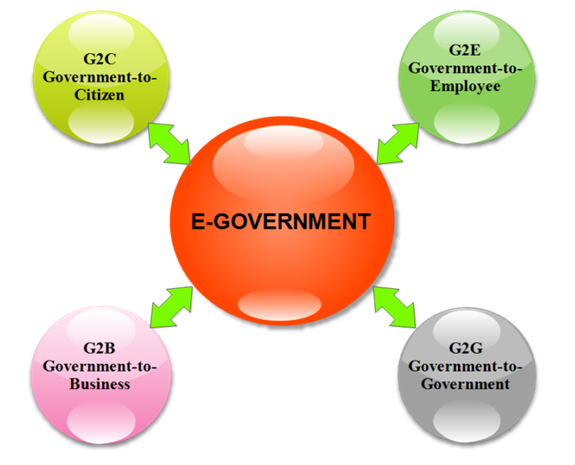 | Figure 1. E-Government interactions [UNESCO] |
2.2. E-Government Dimensions
- The ITU e-government implementation tool kit specifies an e-government environment with four basic dimensions as depicted in figure 2: (1) infrastructure, (2) policy, (3) governance and (4) outreach. [10] While this is not an exhaustive list of dimensions of e-government, these categories are considered to be wide enough to cover all the important aspects of e-government and can, at the same time, be narrowed down to provide useful recommendations on future policy prioritization and activities.
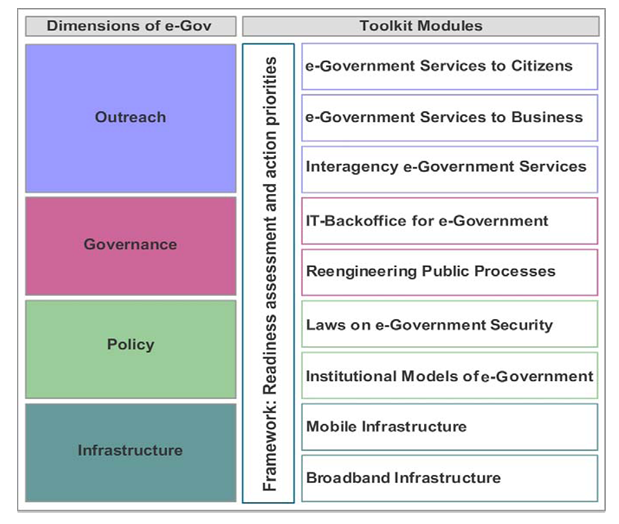 | Figure 2. E-Government dimensions [ITU] |
2.3. Ethics Definitions
- Quinn (2015) gives his definition of ethics as the philosophical study of morality or a rational examination into people’s moral beliefs and behavior. [12] According to Kizza (2007) morality concerns itself with a set of shared rules, principles, and duties, independent from religion, applicable to all in a group or society, and having no reference to the will or power of any one individual whatever his or her status in that group or society. [13]According to Ramadhan et al (2011), the branch of ethics which consists of the analysis of specific, controversial moral issues is called applied ethics. [14] They further say that there are three applied ethics, in the world of computer science, which they use as a reference in their study; these are computer ethics, information ethics, and cyber ethics. Horner, D and Mullen, H (2004) propose a framework to evaluate the extent to which types of ethical issues may be categorized in the use of ICTs. These are shown in figure 3 [15]
 | Figure 3. Evaluative framework of ethical issues [Horner & Mullen] |
2.4. The G2C/G2E Matrix
- This current study develops, proposes and uses a logical framework which the researcher calls The G2C/G2E Matrix (shown in figure 4) to analyze the ethical issues that arise in e-government implementation. In this matrix, traversing vertically through the quadrants, gives the classification of the ethical issues that arise in e-government into two categories; these are internal and external, therefore ethical issues that arise in e-government implementation can be said to either be internal or external. The internal ethical issues arise as a result of the interaction of e-government and the employees of government, both IT and non IT. The external ethical issues arise as a result of the interactions between citizens and all e-processes of government.
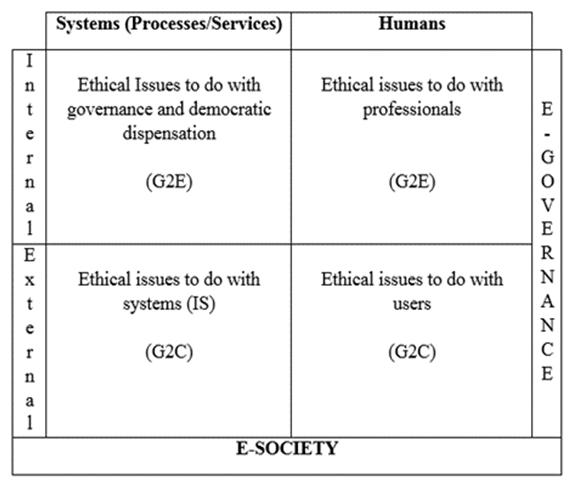 | Figure 4. The G2C/G2E Matrix |
2.5. The Ethical Dimension of Information Systems
- The introduction of new information technology has a ripple effect, raising new ethical, social, and political issues that must be dealt with on the individual, social, and political levels. These issues have five moral dimensions. According to Laudon in the same book, the major ethical, social, and political issues raised by information systems include the following moral dimensions; [17] this is shown in figure 5.- Information rights and obligationsThese involve questions such as, what information rights do individuals and organizations possess with respect to themselves? What can they protect?- Property rights and obligationsThese involve questions such as, how will traditional intellectual property rights be protected in a digital society in which tracing and accounting for ownership are difficult and ignoring such property rights is so easy?- Accountability and controlQuestions that arise are, who can and will be held accountable and liable for the harm done to individual and collective information and property rights?- System qualityQuestions that arise are, what standards of data and system quality should we demand to protect individual rights and the safety of society?- Quality of lifeWhile this brings about questions such as, what values should be preserved in an information- and knowledge-based society? Which institutions should we protect from violation? Which cultural values and practices are supported by the new information technology? In the same book, Laudon draws a picture of society as a more or less calm pond on a summer day, a delicate ecosystem in partial equilibrium with individuals, social and political institutions. Individuals know how to act in this pond because social institutions (family, education, organizations) have developed well-honed rules of behavior, and these are supported by laws developed in the political sector that prescribe behavior and promise sanctions for violations.New information technology and systems are imagined as the disturbing powerful shock of force hitting a society more or less at rest. This therefore sends ripple waves from the centre outwardly across the pond from individual, society to policy level as shown in figure 5.
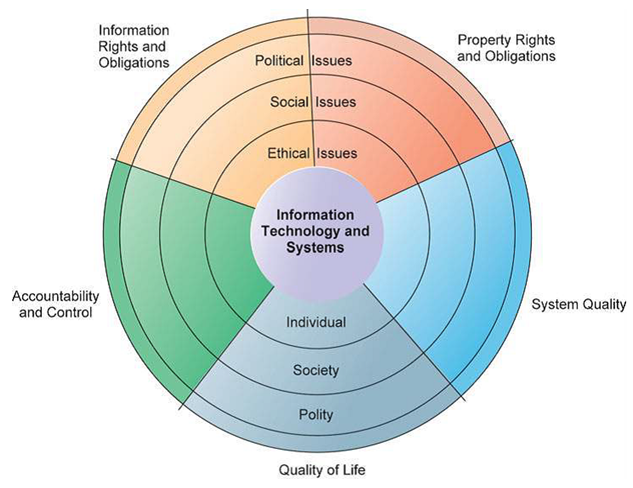 | Figure 5. The relationship between ethical, social and political issues in an information society [Laudon] |
2.6. Ethical Issues in E-Government
- As defined earlier, an ethical issue is a problem or situation that requires a person or organization to choose between alternatives that must be evaluated as right (ethical) or wrong (unethical). Put in a different way, ethical issues are those issues that lend themselves as situations or matters where an individual as a moral being engages his or her moral intellect to make a decision as to whether something is right or wrong.The literature reviewed brought out the following issues as ethical issues that arise in the use of information technology. This is a compilation put together for the purpose of this research within the given constraints of the scope of the study, time and resources; it may not be exhaustive in itself.i. PrivacyQuinn (2007) defines privacy as a “zone of inaccessibility” that surrounds a person. [18] He notes that one has privacy to the extent that they can control who is allowed into their zone of inaccessibility.According to Jerry Durlak in Kizza (2007), privacy is a human value consisting of four elements he calls rights. He puts these rights into two categories. [19] The first category includes three rights that an individual can use to fence off personal information seekers; the second category contains those rights an individual can use to control the amount and value of personal information given out.1. Control of external influences:- Solitude: the right to be alone without disturbances.- Anonymity: the right to have no public personal identity.- Intimacy: the right not to be monitored.2. Control of personal information:- Reserve: the right to control one’s personal information including the methods of dissemination of that information.ii. SecurityAccording to Shailendra Singh and Singh Karaulia (2011) any e-governance initiative will remain venerable to security breaches in absence of a well-articulated security policy. [20] Information security policies are the cornerstone of information security effectiveness. This ethical issue in computing is always considered a subcomponent of data security.Data Security will help the user to control and secure information from, inadvertent or malicious changes and deletions or unauthorized disclosure. There are three aspects of data security:- Confidentiality: refers to protection of information from unauthorized disclosure e.g. to the press or to release through improper disposal techniques, or to those who are not entitled to have the same.- Integrity: is about protecting information from unauthorized modification, and ensuring that information, such as a beneficiary list, can be relied upon and is accurate and complete.- Availability: is to ensure that the information is available when it is required.iii. Computer crimeComputer crime is also are ethical issue. It is defined as a crime like any other crime, except that in this case the illegal act must involve a computer system either as an object of a crime, an instrument used to commit a crime, or a repository of evidence related to a crime. (Kizza, 2007) [21] The acts that fall under this category are considered to be unethical in nature and are criminalized in most societies. These are acts done using computers or computer-related technologies that fall within the limits that the legislature of a state or a nation has specified are considered illegal and may lead to forfeiture of certain civil rights of the perpetrator. Still in the same book, Laudon notes that widespread use of computers increases opportunities for computer crime and computer abuse. [22] New technologies, including computers, create new opportunities for committing crime by creating new valuable items to steal, new ways to steal them, and new ways to harm others. This is all true in the deployment of e-government. iv. Computer decisionsWhen computers are relied upon to make decisions, a new phenomenon of Artificial Intelligence (AI) is created. Nick Bostrom and Eliezer Yudkowsky note that the possibility of creating thinking machines raises a host of ethical issues. [23] The questions that arise relate both to ensuring that such machines do not harm humans and other morally relevant beings, and to the moral status of the machines themselves. Maner’s Starter Kit on Teaching Computer Ethics contains curriculum materials and pedagogical advice for university teachers to develop computer ethics courses. It also includes suggested course descriptions for university catalogs, a rationale for offering such a course in a university, a list of course objectives, some teaching tips, and discussions of topics like privacy and confidentiality, computer crime, computer decisions, technological dependence and professional codes of ethics. [24] This shows that computer decisions were also identified as an ethical issue in the use of information technology.v. Technological dependence (Syndrome)As indicated above, technological dependence is identified as an ethical issue by Maner in his Starter kit. According to Laudon ethical issues long preced information technology. [25] Nevertheless, information technology has heightened ethical concerns, taxed existing social arrangements, and made some laws obsolete or severely crippled. The doubling of computing power every 18 months, among other trends, has made it possible for most organizations to use information systems for their core production processes. As a result, our dependence on systems and our vulnerability to system errors and poor data quality have increased. Social rules and laws have not yet adjusted to this dependence. Standards for ensuring the accuracy and reliability of information systems are not universally accepted or enforced.Qiao Liang and Wang Xiangsui postulate in the introduction to a document entitled Unrestricted Warfare: China’s Master Plan to Destroy America. The People’s Liberation Army printed this document to both trace the strategic and operational successes of the United States’ military, but more importantly to highlight its current weaknesses. In a strictly military sense, these vulnerabilities were through a presumed strength, technology. (Carroll, 2014) [26]vi. Intellectual propertyThe computer revolution, by de-materializing artefacts, products and services and transforming them in strings and streams of digits, has profoundly affected concepts such as ownership, intellectual property, copyright, fair sharing and use, as well as voluntary collaboration and open source software there by raising ethical concerns.Intellectual property is any unique product of the human intellect that has commercial value. Examples of intellectual property are books, songs, movies, paintings, inventions, chemical formulas, and computer programs. (Quinn, 2015) [27]Bernd Carsten Stahl in Floridi (2010) notes that intellectual property is a pervasive issue of ethical relevance that touches many aspects of modern societies. [28] Questions include whether software or content can or should be owned, how they can be protected and how protection mechanisms can be enforced.vii. Computer technology for people living with disabilitiesLazarus (2007) notes that although the current level of access to technology is a recent phenomenon, most people take these conveniences for granted. [29] However, technology may be a mixed blessing for persons with disabilities and pose ethical dilemmas for developers who wish to provide global access for all.viii. Digital divideWhen considered a universal resource that could be used to provide a public service in e-government dispensation, it becomes an ethical issue when ICT tools cannot be afforded by all citizens intended to be served by their government. The questions that arise are:Is there a “digital divide” separating society into “haves” and “have nots”? Is information technology widening the gap between rich and poor? [30]The term “digital divide” refers to the opportunity gap brought about because some people do not have access to modern information technology, particularly the Internet.In other words, digital divide refers to the situation in which some people have access to modern information technology while others do not. The underlying assumption motivating the term is that people who use cell phones, computers, and the Internet have opportunities denied to people without access to these devices.ix. TrustThe oxford dictionary defines trust as the belief that somebody or something is good, sincere, honest, etc. and will not try to harm or trick you. [31] Designing and implementing more effective approaches for achieving e-government is an important issue, because, the governmental information is often so sensitive. Furthermore, security has an important role in trust formation of citizens and their adoption of e-Government. (Gajendra et al, 2012) [32]The information shared by the public should also remain safe and the privacy of the people needs to be preserved. Whenever an individual gets into any transaction with a government agency, he discloses a lot of personal information, which can be misused by the private sector and anti-social elements. (Gajendra Sharma, 2014) [33] e-government success will also depend on how much trust the users have in government to have the capacity and will to safeguard their privacy.x. ReliabilityAccording to Parnas et al. in Kizza (2007) [34], reliability of software is the probability that such a software does not encounter an input sequence that leads to failure. A software product, therefore, is reliable if it can continue to function on numerous unpredictable input sequences. Other measures of reliability include the number of errors in the code. But this also is difficult to take as a good measure because a program with fewer errors is not necessarily more reliable than one with many. Because no system can be certified as error free, including software systems, there have been numerous cases, and will continue to be, in which systems have and will fail the reliability standards. Twizeyimana and Andersson (2019) in their literature review research work whose aim is to come up with a descriptive conceptual framework that improves the understanding of the public value of e-government observe that reliability is an ethical issue. [35]xi. Internet addictionAccording to Michael Quinn, people who use the Internet excessively can harm themselves and others for whom they are responsible. For this reason, excessive Internet use is a moral issue. Kantianism, utilitarianism, and social contract theory, which are ethical theories, all share the Enlightenment view that individuals, as rational beings, have the capacity and the obligation to use their critical judgment to govern their lives [36]. Kant holds that addiction is a vice, because it’s wrong to allow your bodily desires to dominate your mind. Mill in Quinn maintains that some pleasures are more valuable than others and that people have the obligation to help each other distinguish better pleasures from worse ones [37]. Some people spend a great deal of time online, but psychologists disagree whether it is possible to become addicted to the Internet. Samson and Keen in Isfandyari () believe that pornography is among phenomena which are categorized under Internet addiction including net gaming, cyber-relational addiction, information overload, computer addiction and cyber-sexual addiction. [38]xii. LegitimacyThe issue of legitimacy in e-government is discussed when looking at the use of ICT in democratic dispensation in a new concept referred to as e-democracy. Stahl discusses one aspect of the relationship that the use of information and communication technology (ICT) in business has with the use of ICT in government and administration. He argues that democracies rely on their ethical legitimacy and that framing e-government and e-democracy in commercial terms can jeopardize this legitimacy. He goes on to state that this approach not only endanger the success of e-Government and e-Democracy but may even threaten the basis of the moral legitimacy of democratic forms of government. [39]xiii. FairnessAccording to Reynolds (2014), fairness is a virtue. [40] A virtue is a particular good quality or habit (virtue). [41] Virtues are only possessed by human beings by virtue of being moral beings as they are capable of making moral decisions. One is said to be fair if they possess a quality of treating people equally or in a way that is reasonable. In the advent of artificial intelligence and machine learning, where automated information systems are replacing humans and given responsibility once performed by human beings to make decisions. The ability of the systems to perform such duties with fairness is under scrutiny. Therefore, fairness is considered an ethical issue. [42]
3. E-Government in Zambia
- Zambia’s efforts to implement e-government can be traced to the development of the National ICT Policy in 2006. [43] The policy strongly emphasizes the creation of an innovative, market responsive, highly competitive, coordinated and well-regulated ICT industry. The Policy is anchored on thirteen focus areas namely; Human Resources Development, Agriculture, Tourism, Telecommunication infrastructure, Environment and Natural Resources, Education, Health, e-Commerce, e-Government, Youth and Women, Security in information society, Access, media, content and culture and Information and Communication Technology services. [44]Apart from the National ICT Policy, the NISP, 2015-2020 was developed. This was aimed at operationalizing the ICT Policy of 2006 and ensures the integration of ICTs into all sectors of the economy. The Strategy provides a hierarchy of responsibilities, properly focused, time bound for ICT development and a roadmap presenting a series of stages towards achieving the vision and smart targets.In addition, in the consecutive National Development Plans, The ICT Sector has been recognized as a growth sector in the fifth National Development Plan, (2006-2010) and Sixth National Development Plan (including its subsequent revision 2011-2015 and 2013-2016). The sector was classified as an economic sector able to facilitate and contribute to the growth of the economy. The Revised Sixth National development plan focusses on ICT Infrastructure, electronic services and Human Resources Skills development. The Seventh National Development Plan (2017) also places a lot of emphasis on the adoption and prioritization of ICT in the government development agenda.In 2016, the government established the SMART Zambia Institute; a Division under the Office of the President mandated to coordinate and implement electronic government (E-Government) for the citizens, businesses and within government for improved service delivery. [45]The e-government master plan developed earlier but launched by the Zambian government in 2019, among other things provides the scope of the e-government projects. The scope is holistically divided into broad phases of five years each. The initial five years are very important for laying a solid impeccable foundation for the development and sustenance of e-Government in Zambia. Therefore phase one (2016 – 2020) will be focused on the fundamental ICT pillars which according to the Beuchuma Model include;- The governance infrastructure, - The technical infrastructure and - The knowledge infrastructure for the ICT Infrastructure.In an e-Government Assessment Report of the recently conducted survey [46], Zambia is oscillating between web presence and interaction on the e-Government Maturity Model designed by Gartner as shown in figure 6.
 | Figure 6. e-Government Maturity Model [Gartner] |
4. Methodology
- The methodology that is used through this research work is essentially an examination through literature searches and the analysis of data collected from the field through questionnaires and interviews. The data sources did contribute to the objectives resulting in conclusions and recommendations being drawn from the critical analysis of the collected data.The mixed method approach was employed during the research in order to get the benefits of both qualitative and quantitative research designs. The research used both primary and secondary data sources and involved the collecting of data using self-administered questionnaires. The questionnaires were designed with reference to the literature reviewed on the Impact of Ethical Issues on e-government Implementation.The respondents among the policy makers, analysts, regulators, implementers in the ICT industry from various sectors, that is, public and private, as well as ordinary citizens as consumers were the primary sources of data. Published and unpublished books and articles formed the secondary data sources. The primary sources were analyzed based on the facts that were presented in various articles and books that have covered similar topic. Questionnaires were manually and electronically distributed to employees of Smart Zambia Institute (SZI), Zambia Information and Communication Technology Authority (ZICTA), Competition and Consumer Protection Commission (CCPC), Independent Broadcasting Authority (IBA), Ministry of Communications and Transport and other statutory bodies, parastatals and the privately owned companies. The questionnaires were either directly filled in by the respondents or entered after receipt of a hardcopy questionnaire from the respondents who chose to use the hardcopy questionnaire. A total of 115 responses were received for the study with 102 correctly answered, including some directly successfully filled in using Google online survey system by the respondents. [47]According to the ZICTA survey report of 2018, Zambia has a population of 16,899,766, of which 18.5% are in Lusaka Province translating to the population of 3,126,457. It further says that 37% of the Lusaka Province are Internet Users giving a population size of 1,156,105 Internet users in Lusaka Province. [48] Using an online sample size calculator a sample size of 102 is required with confidence level of 95% and marginal error of 9.7. [49]Besides, structured interviews (with open ended questions) were held with respondents across the four tiers of the IT sector to provide qualitative responses to the research. In order to gain in-depth understanding and gather adequate information about the study, the researcher also used secondary data from past researchers on ethical issues in e-government in addition to answers from open ended interviews with e-government policy makers in Zambia.The data analysis uses descriptive and content analysis approaches.
5. Findings
5.1. Presentation of Findings
- The findings are as follows; (to avoid lengthening the document unnecessarily the other demographics are not included in this article).
|
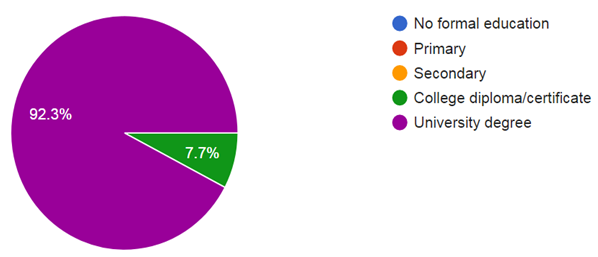 | Figure 7. Formal training |
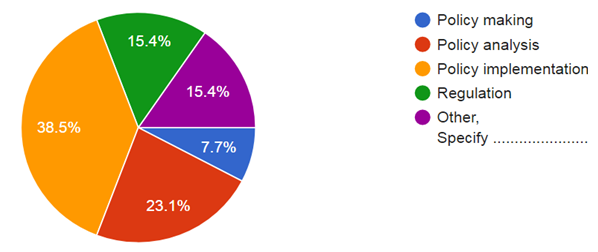 | Figure 8. Classification of roles |
 | Figure 9. Most prominent ethical issue (in Zambia as per survey) |
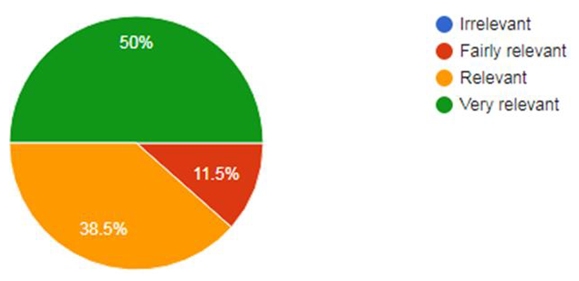 | Figure 10. How relevant to e-government are ethical issue? |
 | Figure 11. Major challenges/Priority areas of e-government in Zambia? |
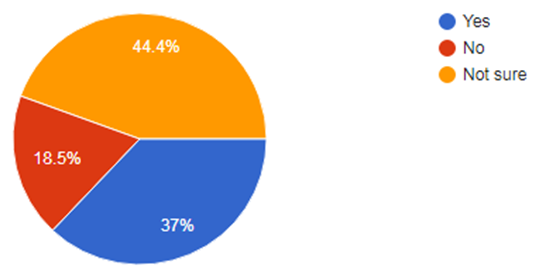 | Figure 12. Knowledge about Zambian E-government policy addressing ethical issues? |
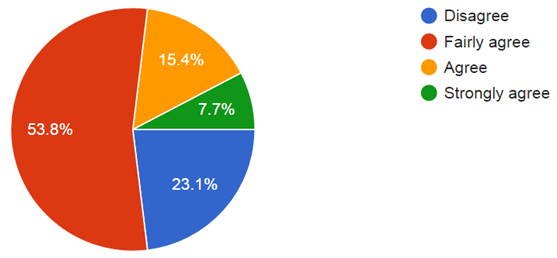 | Figure 13. Other than e-government, do other ICT policies address ethical issues? |
 | Figure 14. Inclusion of ethical issues increases e-government success |
 | Figure 15. Addressing ethical issues increases citizens/business embracing e-government |
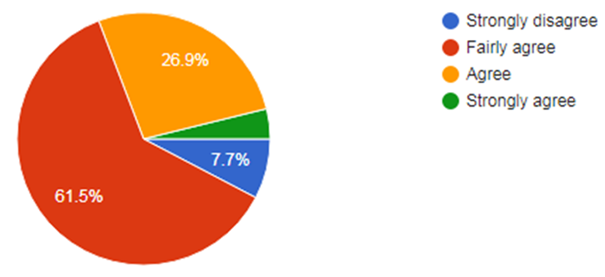 | Figure 16. Policy makers and analysts knowledge of ethical issues impact on e-government |
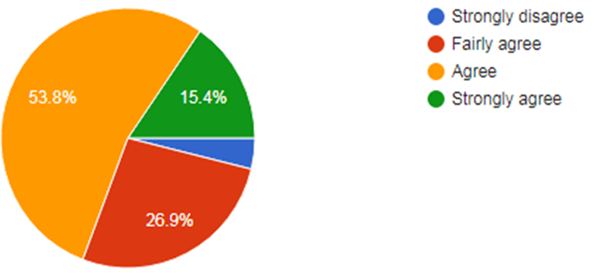 | Figure 17. Information Systems could be designed in such a way as to address ethical issues |
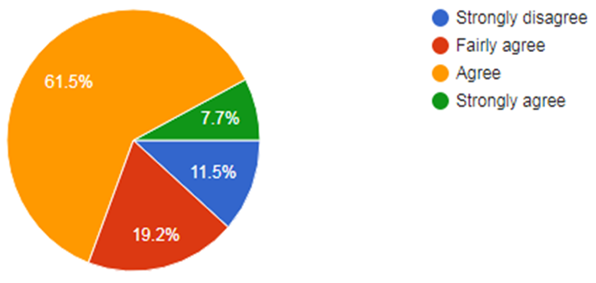 | Figure 18. The design of information systems that address ethical issues is preceded by policy framework |
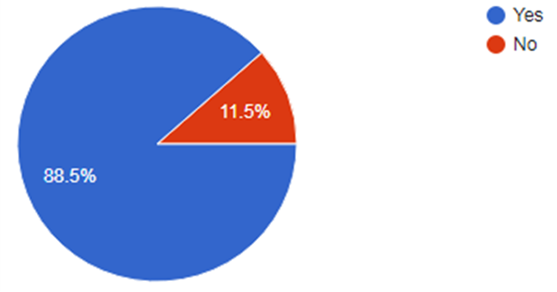 | Figure 19. Developers have a role to play in addressing ethical issues that arise in e-government |
 | Figure 20. The role IT professionals play in addressing these ethical issues |
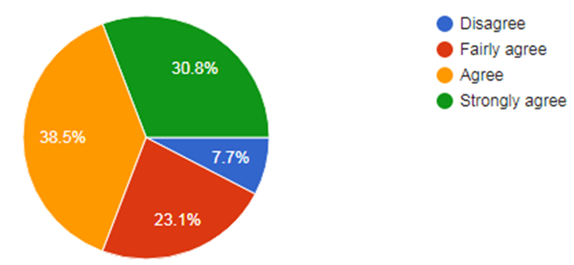 | Figure 21. Professional regulation will help achieve the realization of the above values in the IT professionals |
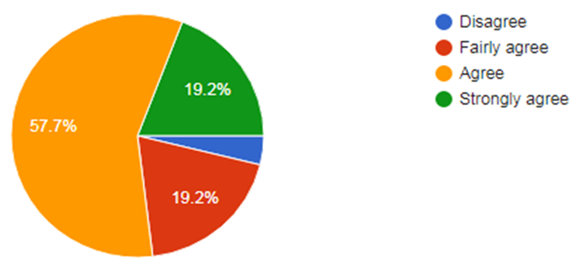 | Figure 22. Professional regulation will increase the confidence and trust in information systems designed for e-government |
5.2. Summary of the Study
- Figure 23, depicts the summary of all the findings related to the two aspects of the research ethical issues and e-government. 42.3% all agree that the inclusion of ethical issues will increase e-government success. 308% strongly agree, 15.4% fairly agree. Only 11.5% disagree.
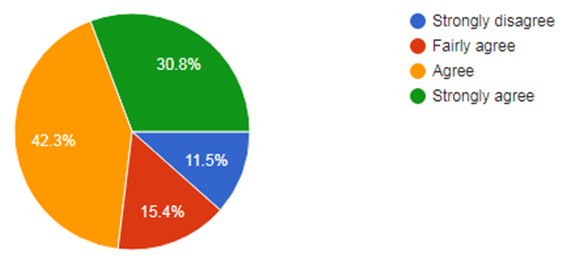 | Figure 23. Would the inclusion of ethical issues contribute to the successful implementation of e-government? |
6. Conclusions
- This paper has brought out the concepts and theories that depict the seemingly salient relationship between ethical issues and e-government in developing countries such as Zambia. The study has demonstrated that ethical issues have an impact on the implementation of e-government. It has also identified a list of some of the ethical issues that arise in e-government implementation. The study has also revealed that these ethical issues arise in the G2C and G2E interactions of e-government as these are the interactions that involve humans who are moral beings. It has also concluded that even in the other interactions, that is G2B and G2G, ethical issues arise due to the fact that humans are still behind these interactions even where these may be automated. The most prominent ethical issues are security and privacy in the order they have been mentioned. The others are, confidentiality, integrity and accountability, good governance and trust, universal access and fairness in that order. Although ethical issues are not immediately identified as a major challenge to e-government implementation in Zambia, it is however noted that their inclusion will increase chances of successful implementation of e-government. As a result the addressing of ethical issues is not prioritised in resource allocation and yet this too has proven to be a challenge in both this study and a survey conducted by ZICTA in 2018. Apart from the e-government policy, there is little acknowledgement that the other existing ICT laws address the ethical issues that arise in e-government. There are indeed ICT laws that to some extent address the ethical issues these are the ICT and ECT Acts both of 2009. The major ethical issues addressed are security and privacy. Worth noting is that these laws have been in existence for 10 years but security and privacy still remain a concern among Internet users. The conclusion made in this study is that both security and privacy are tackled from the infrastructure (systems) perspective and not from the ethical perspective. Ethical issues do not stand out in these laws. Where there mention is made, it is not comprehensive and their impact is acknowledged in salient and the provisions to address them are incidental rather than elaborate.Information systems could be designed in such a way as to address the ethical issues, however, this is preceded by the design of a policy framework. The policy framework identifies or develops a system that will be able to identify all ethical issues that arise in e-government. This will minimize the problem of formulation of policies in silos while increasing coordination in addressing the ethical issues. Value Sensitive Design (VSD) is an approach to design that incorporates notions that technology can have inbuilt tendances to promote or demote particular values. (Floridi, 2010)Developers have a role to play in addressing ethical issues and this role will be realised through professional regulation of IT professionals. This professional regulation will also increase the confidence and trust in the information systems designed for e-government. Ethical issues become even more relevant in the advent of artificial intelligence. According to Bostrom and Yudkowsky (2014), the questions asked relate both to ensuring that such ‘systems’ do not harm humans and other morally relevant beings, and to the moral status of the ‘systems’ themselves. Apart from robots and expert systems, profiling, data mining, machine learning and non-obvious relationship awareness are examples are examples where artificial intelligence is extensively employed in e-commerce with possible use in e-government as well. This study explored an area scarcely studied to understand the impact of ethical issues in the deployment and adoption of e-government. It will provide policy makers and e-government practitioners with basic information that can be used to develop relevant IT policies and design IT systems that address the ethical issues to increase the confidence in end users and e-government success. It will also stimulate more research to understand ethical issues in e-government.
ACKNOWLEDGEMENTS
- Foremost, I would like to acknowledge the Almighty God, for keeping me in good health throughout the rigors and demanding tasks of the research study, and for keeping my mind focused during the long hours and days and nights, spent on searching and researching. My sincere heartfelt gratitude goes to Dr. Simon Tembo for the fatherly guidance and encouragement he gave me during the process of working on this research. The work appeared near impossible in my imagination, but through his valuable support and guidance I managed to deliver expected outcomes.Finally, I would like to express my very profound gratitude to my beloved wife and 3 lovely sons, my parents, and brothers and sisters for providing me with unfailing support and continuous encouragement throughout my years of study and through the process of researching and writing this thesis. This accomplishment would not have been possible without them. Thank you all.
Disclosure
- This section is ONLY for those who requested disclosure. The name of the experts that reviewed your paper, in case they accepted selling disclosure to you, will appear here. Each reviewer is allowed to make their own price for that, since that is a public endorsement of your findings and may be used for varied purposes.
 Abstract
Abstract Reference
Reference Full-Text PDF
Full-Text PDF Full-text HTML
Full-text HTML